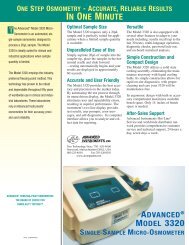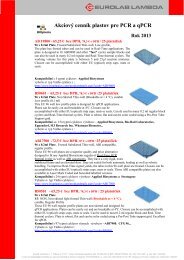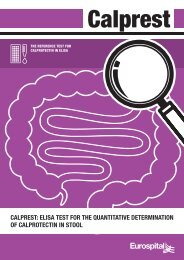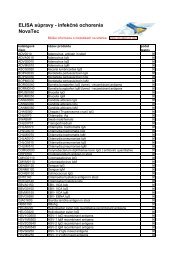Diagnostics Division of AGROLABO SpA group
Diagnostics Division of AGROLABO SpA group
Diagnostics Division of AGROLABO SpA group
You also want an ePaper? Increase the reach of your titles
YUMPU automatically turns print PDFs into web optimized ePapers that Google loves.
The LYME IC test is a ready-to-use assay that provides clear, easy-to-interpret screening results in<br />
under 10 minutes. This carefully designed diagnostic tool accurately detects antibodies to<br />
Borrelia burgdorferi in small amounts <strong>of</strong> canine sera. Available in several kit formats, all <strong>of</strong> which<br />
stored at room temperature, the LYME IC test provides qualitative, cost-effective, in-house<br />
diagnostics that can be trusted.<br />
Sensitivity: 90%<br />
Available pack sizes:<br />
Specific for:<br />
Pathology:<br />
Method:<br />
Analyte:<br />
Capture molecules:<br />
Sample:<br />
Total run-time:<br />
Hands-on time:<br />
Result reading:<br />
Additional materials:<br />
Storage temperature:<br />
Shelf life:<br />
Instructions:<br />
1, 2, 5, 10 test kits<br />
dogs<br />
Lyme disease<br />
Immunochromatographic<br />
Antibody<br />
Purified antigen<br />
Plasma, serum, whole blood<br />
5 -10 minutes<br />
1 minute<br />
Visual<br />
All materials/instruments provided<br />
Room temperature (18-25°C)<br />
12 months from production date<br />
Multilingual<br />
Specificty: 98.6%<br />
Borreliosis (or Lyme disease) is an arthropode-born, bacterial disease <strong>of</strong> man and<br />
animals; among these the most affected are the dogs.<br />
The causative agent is a spirochete, Borrelia burgdorferi, whose vectors are ticks<br />
<strong>of</strong> the species Ixodes ricinus; both larvae and nymphs acquire the infection by<br />
feeding on infected reservoir hosts (primarily small mammals as small wild<br />
rodents) and transmitting the infection to the subsequent hosts; the highest<br />
incidence is observed in spring and autumn.<br />
Therapy is based on the administration <strong>of</strong> antibiotics (penicillin and tetracycline),<br />
usually followed by a rapid regression <strong>of</strong> symptoms (primarily in joints) <strong>of</strong> most<br />
animals. A limited number <strong>of</strong> animals show persistence <strong>of</strong> infection in spite <strong>of</strong> the<br />
antibiotic therapy. A symptomatic therapy must be considered, especially for the<br />
renal, cardiac and neurologic syndromes, with administration <strong>of</strong> non-steroidal<br />
anti-inflammatory drugs in case <strong>of</strong> swollen and painful joints.<br />
Prophylaxis is based on avoidance <strong>of</strong> contacts with ticks and applications <strong>of</strong> tick<br />
control products or collars. For the dog is available an inactivated vaccine, to be<br />
administered at 12 weeks <strong>of</strong> age, again after 3 to 5 weeks, and annually.<br />
The most common<br />
symptoms <strong>of</strong> Lyme disease<br />
in dogs are: fever, anorexia,<br />
lethargy, lameness with<br />
swollen joints and<br />
lymphadenopathy. In renal<br />
borreliosis, generally fatal,<br />
uremia, proteinuria, ascites<br />
and edema are usually<br />
observed. The cardiac form<br />
is accompanied by<br />
conduction abnormalities<br />
and bradycardia, while in<br />
the neurologic form the<br />
most common symptoms<br />
are represented by facial<br />
paralysis and seizures.<br />
16















